|
Category
|
Shahi Zinda Mausoleum complex
Extant complex consists of eleven mausoleums, is attached in series to each other during the XIV-XV centuries. However, in the course of excavations on the eastern slope of the ancient Afrasiab discovered the remains of the mausoleums XI-XII centuries. In 2001 the ensemble of Shahi Zinda mausoleums, along with other ancient buildings of Samarkand is included in the UNESCO World Heritage List. The oldest buildings of the ensemble, from which only the base and preserved tombs date back to XI-XII centuries. The vast majority of the buildings belong to the XIV-XV century, and the restructuring of XVI-XIX centuries virtually no effect on the composition and appearance of the complex.
Shahi Zinda - the only one in Samarkand, archeological and architectural monument, which, including the cultural layers of Afrasiab, affected nearly three thousand years history of the city. The entrance portal of the complex is the newest of its construction. Inside the building of the ensemble can be divided into lower, middle and upper groups, which are connected by arch-domed passages - Chartak. In the lower group of buildings on the terrace near the entrance is located two-dome Kazi-zade ar-Rumi mausoleum, a mathematician and astronomer of Ulugbek's era. Rumi was a teacher and associate of Ulugbek. He did not amassed for his life or riches or land did not belong to a noble family. But he was the greatest mathematician and astronomer of his time, and because the tomb of Rumi Ulugbek built beside the mausoleums of the Khans and queens and made it just a little, but taller.
Center of the whole ensemble is complex of Kusam ibn-Abbas, which includes several buildings, among which the most ancient - the mausoleum Kusam ibn-Abbas and Mosque by the XVI century. The complex has a door with the date 1404-1405. Decorated with carvings and original inlaid with ivory.
Headstone of Kussam is artistically the best of tile tombs of Central Asia. It consists of four successive diminishing tiers and decorated with glazed tiles, which is dominated by bright colors: blue, dark blue, yellow and white, there is a green color, an abundance of striking gold. On the lateral surfaces of the third and fourth tiers of gravestones inscribed in gold quotations from the Koran. On the lateral surfaces of the upper states: "This is the tomb of her son's uncle Sayid, envoy of the last of the prophets, the messenger lord of the worlds, peace be upon him", "Commander of the Faithful - Kussam, the son of Abbas. May Allah be pleased with them both and make them our intercessors. Died in '57. " (676-677 years). The inscription on the wooden door leading into the cemetery of the mosque of Shahi Zinda, reads: "Said the Prophet Arabic, Hashamic, Kurayshian, Meccan and Medina, let it be upon him peace: Kussam, son of Abbas, like me more than any other of its appearance and character".
In 2005, Shahi Zinda has undergone a global restoration, during which the streets of the mausoleums of the fence, towering on the right side of the tracks were removed in order to open space, which found a mosque, madrasa early medieval (XI cent.) and traces of earlier mausoleums . The architectural ensemble Shahi Zinda, which is a whole street of mosques and mausoleums, is a true museum of glazed decor XIV-XV centuries. Here there are carved and glazed terra-cotta and painted majolica, inlaid designs and beautiful mosaics and large mosaics of glazed bricks. For details, elegance and diversity none of the architectural monuments of Samarkand can not be compared with the Shahi Zinda mausoleums. Shahi Zinda is good everywhere. And from the top of the hill, where we see two blue domes of the chain, and the bottom - a colorful arch narrow street portals, and the distance from the city, when it seems the page dreamed of fairy tales Scheherazade, and near where he was surprised by the richness and exuberance of fancy colors. It is small, but more impressive than the magnificent mosques and minarets of the other grand eastern capitals. In preparing the articles used material from the site www.wikipedia.org, www.e-samarkand.narod.ru and www.samarkand-foto.ru |
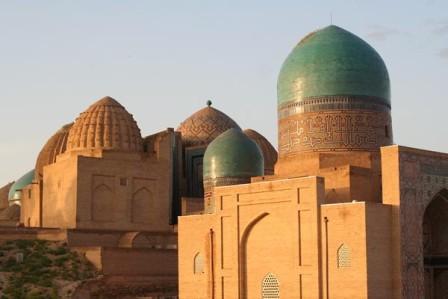 On the northern outskirts of Samarkand, on the edge of Afrasiab hill, at the vast ancient cemetery, is a complex of mausoleums Shahi Zinda (Persian - «The Living King"), among which the most famous is the Mausoleum of Kussam ibn Abbas, a cousin of the Prophet Muhammad. Shahi Zinda ensemble was formed during nine centuries and includes more than twenty plants IX-XIV and XIX centuries. His name Shohi Zinda - "The Living King" - a set of required legend. It says that a cousin of the Prophet Muhammad, Kusam Ibn Abbas came to Samarkand with a small army for approval Islam. During one of the raids of the Gentiles Kusam ibn Abbas was struck by an arrow, but managed to escape from the eyes of the infidels in the crevice formed (in another version, in the well), so he got to heaven, where he lives to this day.
On the northern outskirts of Samarkand, on the edge of Afrasiab hill, at the vast ancient cemetery, is a complex of mausoleums Shahi Zinda (Persian - «The Living King"), among which the most famous is the Mausoleum of Kussam ibn Abbas, a cousin of the Prophet Muhammad. Shahi Zinda ensemble was formed during nine centuries and includes more than twenty plants IX-XIV and XIX centuries. His name Shohi Zinda - "The Living King" - a set of required legend. It says that a cousin of the Prophet Muhammad, Kusam Ibn Abbas came to Samarkand with a small army for approval Islam. During one of the raids of the Gentiles Kusam ibn Abbas was struck by an arrow, but managed to escape from the eyes of the infidels in the crevice formed (in another version, in the well), so he got to heaven, where he lives to this day.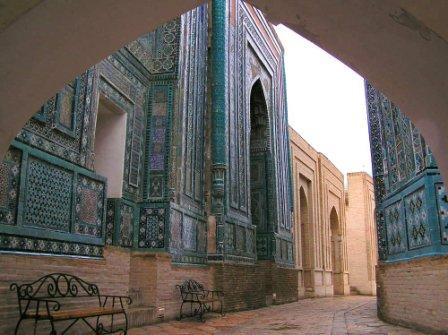 Already in the XII century, near the grave of Kussam Ibn Abbas was buried who used a special respect. For the first time, a detailed description of the Mausoleum gives the Arab traveler, "Herodotus of the Arab world" - Ibn Battuta, who visited Samarkand in the 30s of the XIV century, and ranked him "among the largest, well-equipped and beautiful city": "The grave is blessed. Over it is erected a square building with a dome, at every corner there are two marble columns, marble, green, black, white and red. The walls of the building, too, from multi-colored marble with gold ornaments, the roof is made of lead. " Since then, the building was rebuilt several times, and faced the blue and colored tiles and mosaics.
Already in the XII century, near the grave of Kussam Ibn Abbas was buried who used a special respect. For the first time, a detailed description of the Mausoleum gives the Arab traveler, "Herodotus of the Arab world" - Ibn Battuta, who visited Samarkand in the 30s of the XIV century, and ranked him "among the largest, well-equipped and beautiful city": "The grave is blessed. Over it is erected a square building with a dome, at every corner there are two marble columns, marble, green, black, white and red. The walls of the building, too, from multi-colored marble with gold ornaments, the roof is made of lead. " Since then, the building was rebuilt several times, and faced the blue and colored tiles and mosaics.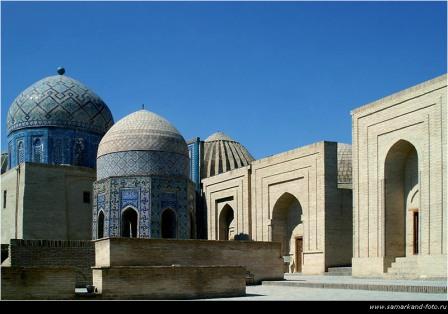 The middle group of buildings consists of a group of mausoleums of Timur's time, the burial place of his relatives and prominent military and religious leaders. These buildings date from the last quarter of the XIV - XV centuries beginning. Among them are the mausoleums of Amir-Zadeh (1386), Tuglu-Tekin, daughter of Amir Khoja, Timur's niece Shadi-Mulk (Turkan) (1371-1372) and Timur's sister Shirin Bika (1385-1386). The last two mausoleums are best preserved. The main facades of these buildings are composed of small one-hall in the form of a portal with a rich and colorful decor. Not far from the mausoleum of Shirin Bika, markedly different from other facilities, located Octagonal mausoleum of the first half of the XV century to open on the sides of openings. It is decorated with mosaics of glazed bricks, and probably was initially blocked by a dome on a high cylindrical drum.
The middle group of buildings consists of a group of mausoleums of Timur's time, the burial place of his relatives and prominent military and religious leaders. These buildings date from the last quarter of the XIV - XV centuries beginning. Among them are the mausoleums of Amir-Zadeh (1386), Tuglu-Tekin, daughter of Amir Khoja, Timur's niece Shadi-Mulk (Turkan) (1371-1372) and Timur's sister Shirin Bika (1385-1386). The last two mausoleums are best preserved. The main facades of these buildings are composed of small one-hall in the form of a portal with a rich and colorful decor. Not far from the mausoleum of Shirin Bika, markedly different from other facilities, located Octagonal mausoleum of the first half of the XV century to open on the sides of openings. It is decorated with mosaics of glazed bricks, and probably was initially blocked by a dome on a high cylindrical drum.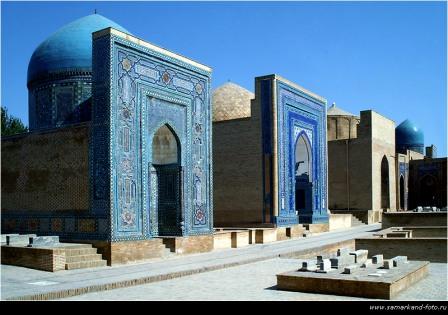 Mausoleum of Kussam adjacent to the so-called "small mosque" - Ziyorat-khona, dating from the year 735 AH (1334-1335 years), and is the oldest surviving buildings in Samarkand. Ziyorat-khona is separated from the mausoleum of wooden bars with intricate carvings.
Mausoleum of Kussam adjacent to the so-called "small mosque" - Ziyorat-khona, dating from the year 735 AH (1334-1335 years), and is the oldest surviving buildings in Samarkand. Ziyorat-khona is separated from the mausoleum of wooden bars with intricate carvings.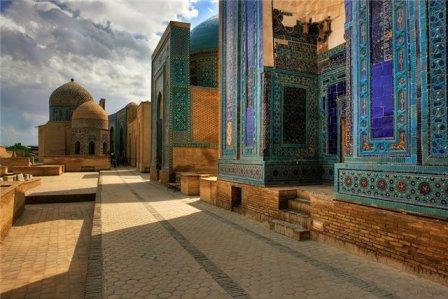 The upper group consists of three buildings standing opposite each other mausoleum, as if beauty contestants facing and forming a lovely shaded patio. The northern part of the yard is closed mausoleum of Khoja Ahmad, built before Timur time in 1340th years. The eastern and western sides of the courtyard surrounded by Nameless mausoleum (1360-1361) and Tuman-aka mausoleum beginning of the XV century.
The upper group consists of three buildings standing opposite each other mausoleum, as if beauty contestants facing and forming a lovely shaded patio. The northern part of the yard is closed mausoleum of Khoja Ahmad, built before Timur time in 1340th years. The eastern and western sides of the courtyard surrounded by Nameless mausoleum (1360-1361) and Tuman-aka mausoleum beginning of the XV century.














